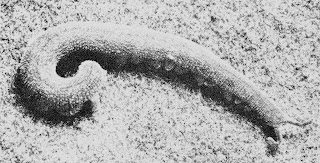Velvet worms are the common name of a group of animals belonging to the phylum Onychophora. They have features similar to both annelid worms and arthropods and look very much like slugs with legs.
The anterior region of the body bears two large antennae, a ventral mouth that is flanked by a pair of claw-like mandibles, and a pair of short, conical oral papillae. They have between 14 and 43 pairs of legs, each of which is a large, conical, unjointed protuberance bearing a pair of terminal claws. The entire surface of the body is covered by tubercles, which are arranged in rings or bands encircling the legs and trunk. The tubercles are covered in minute scales. Onychophorans are blue, green, orange, or black, and the scales give the body a velvety and iridescent appearance.
There are about seventy living species of onychophorans, most of which live in humid habitats, such as in tropical rainforests, beneath logs, stones, and leaves, or along stream banks.
Most species are predaceous and are able to secrete an adhesive material from glands opening at the ends of the oral papillae. This secretion is discharged as two projectile streams and it hardens almost immediately, trapping the prey in a net of adhesive threads. The mouth is flanked by lateral, clawlike mandibles, which are used for grasping and cutting prey. Salivary secretions are injected into the body of the prey, and they partially-digested tissues are sucked into the mouth.
The fossil record of onychophorans extends back to the Cambrian period, and the group is represented by two marine genera in the Burgess Shale: Aysheia, and Hallucigenia
Aysheia
Hallucigenia is a truly unusual creature, named for its 'bizarre and dream-like quality. It has seven pairs of spines on its dorsal surface and seven pairs of clawed tentacles on the ventral surface. It was first reconstructed as walking on the spines, like stilts, with its tentacles waving in the water. However, exceptionally preserved fossils from the Lower Cambrian Chengjiang Fauna of China revealed that the tentacles were actually long, clawed walking appendages and that the spines served to protect the dorsal side of the animal.
Hallucigenia





Velvet worms are the first (and probably only) animal I've recognized in your Weird Wednesday segment.
ReplyDeleteThese are great to read.
I'm glad you're enjoying them - I thought it would be a fun change of pace from old-school ranting :)
ReplyDeleteSo far the velvet worms are the only group I've described that didn't go extinct at the end of the Cambrian. As I begin to run out of weird Cambrian wonders I'll start tapping more living groups that will (possibly) be more familiar to people. Tardigrades (water bears) will be coming up soon...